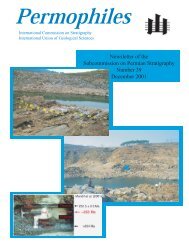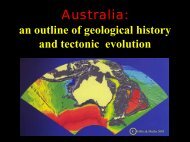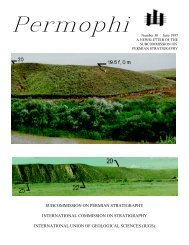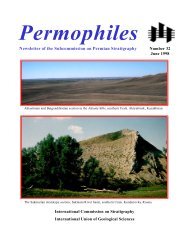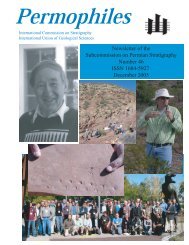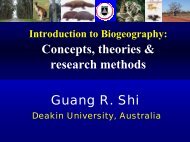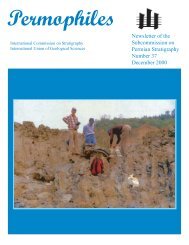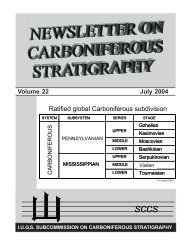Number 31 January 1998 Newsletter of the Subcommission on ...
Number 31 January 1998 Newsletter of the Subcommission on ...
Number 31 January 1998 Newsletter of the Subcommission on ...
You also want an ePaper? Increase the reach of your titles
YUMPU automatically turns print PDFs into web optimized ePapers that Google loves.
to meetings <str<strong>on</strong>g>of</str<strong>on</strong>g> <str<strong>on</strong>g>the</str<strong>on</strong>g> 9 th Internati<strong>on</strong>al C<strong>on</strong>gress <strong>on</strong> Carb<strong>on</strong>iferous<br />
Stratigraphy and Geology that was held in Urbana, Illinois.<br />
Physical and chemical nature <str<strong>on</strong>g>of</str<strong>on</strong>g> <str<strong>on</strong>g>the</str<strong>on</strong>g> Permian/Triassic boundary<br />
and <str<strong>on</strong>g>the</str<strong>on</strong>g> distributi<strong>on</strong> <str<strong>on</strong>g>of</str<strong>on</strong>g> rocks and fossils in China formed <str<strong>on</strong>g>the</str<strong>on</strong>g><br />
primary bases for discussi<strong>on</strong>.<br />
Subsequent activities <str<strong>on</strong>g>of</str<strong>on</strong>g> <str<strong>on</strong>g>the</str<strong>on</strong>g> <str<strong>on</strong>g>Subcommissi<strong>on</strong></str<strong>on</strong>g> are covered in<br />
<str<strong>on</strong>g>the</str<strong>on</strong>g> 30 issues <str<strong>on</strong>g>of</str<strong>on</strong>g> SPS <str<strong>on</strong>g>Newsletter</str<strong>on</strong>g>s/Permophiles published 1979-<br />
<str<strong>on</strong>g>1998</str<strong>on</strong>g>.<br />
Brian F. Glenister<br />
Department <str<strong>on</strong>g>of</str<strong>on</strong>g> Geology<br />
University <str<strong>on</strong>g>of</str<strong>on</strong>g> Iowa<br />
Iowa City, IA 52242, U.S.A.<br />
Reference<br />
Van Der Plas, L. and Tobi, A.C., (1965). A chart for judging <str<strong>on</strong>g>the</str<strong>on</strong>g><br />
reliability <str<strong>on</strong>g>of</str<strong>on</strong>g> point counting results. American Journal <str<strong>on</strong>g>of</str<strong>on</strong>g> Science,<br />
vol. 263, p. 87-90.<br />
Michael T. Dunn<br />
Department <str<strong>on</strong>g>of</str<strong>on</strong>g> Geosciences<br />
Boise State University<br />
Boise, ID 83725 USA<br />
mdunn@trex.idbsu.edu<br />
W. W. Nassichuk<br />
Geological Survey <str<strong>on</strong>g>of</str<strong>on</strong>g> Canada (Calgary)<br />
3303 - 33rd Street NW<br />
Calgary, Alberta T2L,2A7 Canada<br />
Preliminary Palynological Assessment <str<strong>on</strong>g>of</str<strong>on</strong>g> Selected<br />
Horiz<strong>on</strong>s Across <str<strong>on</strong>g>the</str<strong>on</strong>g> Carb<strong>on</strong>iferous/Permian<br />
Boundary, Aidaralash Creek, Kazakhstan.<br />
by Michael T. Dunn<br />
An abundant, diverse, and well-preserved palynological<br />
assemblage has been obtained from several horiz<strong>on</strong>s <str<strong>on</strong>g>of</str<strong>on</strong>g> strata<br />
across <str<strong>on</strong>g>the</str<strong>on</strong>g> Carb<strong>on</strong>iferous/Permian Boundary in Aidaralash Creek,<br />
Kazakhstan. The samples span 50.2 meters <str<strong>on</strong>g>of</str<strong>on</strong>g> secti<strong>on</strong>, from 24.2<br />
meters below to 26.0 meters above <str<strong>on</strong>g>the</str<strong>on</strong>g> base <str<strong>on</strong>g>of</str<strong>on</strong>g> Permian (base <str<strong>on</strong>g>of</str<strong>on</strong>g><br />
bed 19, Fig. 1). The assemblage is dominated by disaccate<br />
pollen grains. Palynomorph populati<strong>on</strong>s have been assessed<br />
from a count <str<strong>on</strong>g>of</str<strong>on</strong>g> 300 palynomorphs per slide after Dan Der Plas<br />
and Tobi (1965).<br />
Percentage occurrences for <str<strong>on</strong>g>the</str<strong>on</strong>g> sample recovered from 26.0<br />
MAB are shown <strong>on</strong> Figure 2. Disaccate pollen grains c<strong>on</strong>stitute<br />
51 percent <str<strong>on</strong>g>of</str<strong>on</strong>g> <str<strong>on</strong>g>the</str<strong>on</strong>g> sample (Table 1); comm<strong>on</strong> genera include<br />
Hamiapollenites, Protohaploxypinus, and Pityosporites.<br />
Taeniate polyplicates are sec<strong>on</strong>d in abundance at 17.6 percent,<br />
with Vittitina <str<strong>on</strong>g>the</str<strong>on</strong>g> most comm<strong>on</strong> genus <str<strong>on</strong>g>of</str<strong>on</strong>g> this group.<br />
M<strong>on</strong>osaccate pollen grains are <str<strong>on</strong>g>the</str<strong>on</strong>g> third most abundant group<br />
at 11.3 percent <str<strong>on</strong>g>of</str<strong>on</strong>g> <str<strong>on</strong>g>the</str<strong>on</strong>g> populati<strong>on</strong>; Cordaitina uralensis and<br />
several species <str<strong>on</strong>g>of</str<strong>on</strong>g> Pot<strong>on</strong>ieisporites have thus far been identified.<br />
Trilete spores make up 10.6 percent <str<strong>on</strong>g>of</str<strong>on</strong>g> <str<strong>on</strong>g>the</str<strong>on</strong>g> sample and<br />
comm<strong>on</strong> genera <str<strong>on</strong>g>of</str<strong>on</strong>g> this group include Punctatisporites, and<br />
Leiotriletes. Trilete z<strong>on</strong>ate spores are <str<strong>on</strong>g>the</str<strong>on</strong>g> least numerous group<br />
at 8.3 percent and include Densosporites, Grandispora, and<br />
Knoxisporites. Several representatives <str<strong>on</strong>g>of</str<strong>on</strong>g> <str<strong>on</strong>g>the</str<strong>on</strong>g> latter two groups<br />
<str<strong>on</strong>g>of</str<strong>on</strong>g> spores include reworked Dev<strong>on</strong>ian and Carb<strong>on</strong>iferous forms<br />
(Utting, <str<strong>on</strong>g>1998</str<strong>on</strong>g>, pers<strong>on</strong>al communicati<strong>on</strong>).<br />
Acknowledgments<br />
I would like to thank Brenda Davies and John Utting, Institute<br />
for Sedimentary and petroleum Geology, Geological Survey<br />
<str<strong>on</strong>g>of</str<strong>on</strong>g> Canada, Calgary, Alberta, for assistance in preparati<strong>on</strong><br />
and identificati<strong>on</strong> <str<strong>on</strong>g>of</str<strong>on</strong>g> samples and The Geological Society <str<strong>on</strong>g>of</str<strong>on</strong>g><br />
America for funding travel to Calgary.<br />
10<br />
Figure 1. Stratigraphic column <str<strong>on</strong>g>of</str<strong>on</strong>g> porti<strong>on</strong> <str<strong>on</strong>g>of</str<strong>on</strong>g> <str<strong>on</strong>g>the</str<strong>on</strong>g> secti<strong>on</strong> at Aidaralash<br />
Creek, Aktöbe regi<strong>on</strong>, Kazakhstan. Carb<strong>on</strong>iferous/Permian boundary proposed<br />
<strong>on</strong> <str<strong>on</strong>g>the</str<strong>on</strong>g> basis <str<strong>on</strong>g>of</str<strong>on</strong>g> c<strong>on</strong>od<strong>on</strong>ts, fusulinaceans, and amm<strong>on</strong>iods, is indicated.<br />
Bed numbers (e.g., 19) and subdivisi<strong>on</strong>s (e.g., 19.5) represent<br />
designati<strong>on</strong>s widely used in recent Soviet/Russian literature; “a”, “f”, and<br />
“c” indicate amm<strong>on</strong>iod, fuslinacean, and c<strong>on</strong>od<strong>on</strong>t occurrences. Palynological<br />
horiz<strong>on</strong>s are indicated by “p”. Zero meters marks <str<strong>on</strong>g>the</str<strong>on</strong>g> point<br />
defining <str<strong>on</strong>g>the</str<strong>on</strong>g> base <str<strong>on</strong>g>of</str<strong>on</strong>g> <str<strong>on</strong>g>the</str<strong>on</strong>g> Permian System.<br />
Figure 2. Percentage <str<strong>on</strong>g>of</str<strong>on</strong>g> major palynomorph groups from sample at 26.o<br />
MAB, Aidaralash Creek, Kazakhstan. Di-sac = disaccate pollen grains;<br />
Taen poly = taeniate polyplicate pollen grains; M<strong>on</strong>o-sac = m<strong>on</strong>osaccate<br />
pollen grains; Tri-rad = trilete radial spores; Tri-z<strong>on</strong>e = trilete radial<br />
z<strong>on</strong>ate/cingulate spores.



